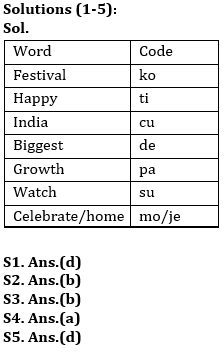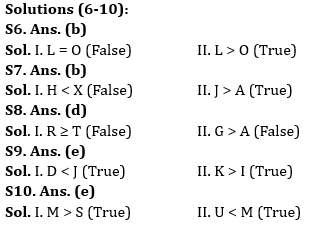Directions (1-5): Study the following information carefully to answer the given questions.
In a certain code language,
‘Festival celebrate happy home India’ is written as ‘ti cu ko mo je’,
‘India Biggest festival’ is written as ‘de cu ko’,
‘Biggest growth India’ is written as ‘cu pa de’
‘Festival happy watch India’ is written as ‘cu ti ko su’.
Q1. Which of the following is the code of word ‘home’?
(a) je
(b) ti
(c) mo
(d) Either (a) or (c)
(e) None of these
Q2. What does ‘ti’ stand for?
(a) Festival
(b) Happy
(c) Home
(d) Watch
(e) Can’t be determined
Q3. Which of the following will be the code for ‘India watch festival’?
(a) su cu ti
(b) su ko cu
(c) ti ko cu
(d) ko mo su
(e) None of these
Q4. Which of the following may be the possible code for ‘festival should happy watch India’?
(a) cu ti ko su ye
(b) ye ti su ko mo
(c) cu ti mo su ye
(d) ti ko cu ye je
(e) None of these
Q5. Which of the following is the code of word ‘Biggest’?
(a) mo
(b) je
(c) ko
(d) de
(e) Can’t be determined
Directions (6-10): In the following questions assuming the given statement to be true, find which of the conclusion(s) among given conclusions is/are definitely true and then give your answers accordingly.
Q6. Statement: T > M > O ≤ D, L = K > S > D ≥ B
Conclusions: I. L = O
II. L > O
(a) Only I is true
(b) Only II is true
(c) Either I or II is true
(d) Neither I nor II is true
(e) Both I and II are true
Q7. Statement: L > K ≤ J = H > G = F > D > S = A < Z < X < C = V
Conclusions: I. H < X
II. J > A
(a) Only I is true
(b) Only II is true
(c) Either I or II is true
(d) Neither I nor II is true
(e) Both I and II are true
Q8. Statements: G > S > O = P < R, O ≥ T > B > W ≤ A
Conclusions: I. R ≥ T
II. G > A
(a) Only I is true
(b) Only II is true
(c) Either I or II is true
(d) Neither I nor II is true
(e) Both I and II are true
Q9. Statements: D ≤ E < F = G; J > F > H > I; L > J < K
Conclusions: I. D < J II. K > I
(a) Only I is true
(b) Only II is true
(c) Either I or II is true
(d) Neither I nor II is true
(e) Both I and II are true
Q10. Statements: P > O ≤ N < M; S < O ≤ Q ≤ R; S > T > U
Conclusions: I. M > S II. U < M
(a) Only I is true
(b) Only II is true
(c) Either I or II is true
(d) Neither I nor II is true
(e) Both I and II are true
Solutions







 GA Capsule for SBI Clerk Mains 2025, Dow...
GA Capsule for SBI Clerk Mains 2025, Dow...
 The Hindu Review October 2022: Download ...
The Hindu Review October 2022: Download ...
 30 Days Study Plan to Crack SBI Clerk 20...
30 Days Study Plan to Crack SBI Clerk 20...





